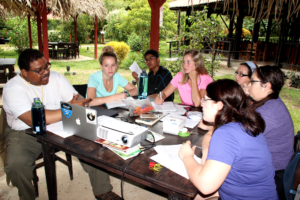By: Alessandra Santiago
Back in November, we covered the primary application and your personal statement. The written components of your primary application include your 15 extracurricular activities and personal statement, and these two components provide the application committee a full picture of who you are as a candidate.

In January of your application cycle, the primary application is still four months away from opening, so now is a good time to jot down some preliminary ideas for the personal statement prompt (Remember: this tops out at 5300 characters, so you should aim for 1-1.25 pages of total writing). This is an opportunity to distinguish yourself from other applicants, so start by compiling a bullet point list of answers to the following questions:
- What makes you uniquely qualified for practicing medicine?
- Why have you chosen the field of medicine?
- Why do you want to become a doctor? Why not nursing? Chaplaincy? Marriage and Family Therapy Counseling?
- What unique hardships, challenges, or obstacles have you faced, and how have they influenced your educational pursuits?
- Consider commenting on significant deviations in your academic record and/or disclose other information about you that you have not covered in other areas of your application.
For more writing prompts to get you started, check out our personal statement article. Start thinking about your initial, straight-from-the-gut answers to these questions. Using one or two specific incidents to show what you have learned from your experiences in medicine can demonstrate to admissions committees how you are uniquely suited for their school. Jot down your reflections, experiences, and ideas as you begin the writing process.

And speaking of the writing process, there should be structure to your overall approach to crafting your story. For the primary application, it is important to focus on concrete examples: narrow in on one or two incidents, such as a life-changing personal experience with healthcare or a relationship with a medical professional, and describe how these incidents illustrate how your strengths align with the AAMC’s core competencies for pre-meds.
As you write, DO NOT DELETE ANYTHING! What you brainstorm now may serve as fodder for secondary applications later on. Keep what you write—even if it doesn’t make it into the primary application—and figure out which of your drafts paint you as the best possible candidate. Start creating full drafts from your bullet points towards the end of February or beginning of March. Expect to spend at least two months on writing, revising, and receiving feedback before your personal statement is finalized.

Once you’ve written and decided on a draft, edit with a fine-toothed comb. Be meticulous about checking for punctuation and grammatical errors (editor’s hint: don’t rely solely on your computer’s spell check function!). Read your draft out loud—to yourself and to an audience—to check for flow as well as its overall effectiveness at painting a picture of you.
Finally, seek out qualified people in your life to read it and provide feedback. These people can be your family members, a trusted friend, an academic counselor from your school, your partner, etc. Be careful to select readers who know you personally as well as professionally; you want a good mix of readers to provide edits that reflect your academic potential as well as your personal potential as a future care provider.
| Assignment #11: Begin brainstorming your personal statement! Start by making bullet points to the prompts listed above. Jot down the highlights of your experiences in healthcare thus far. At the beginning of March, start writing your first draft. Be prepared to write several drafts as you go. Save everything! Select who you wish to read and provide feedback on your draft. |
Want more writing tips? Check out our next article coming in two weeks, where we will cover the writing pitfalls to avoid and other boxes to check on the primary app.
If you want to learn more about navigating the Pre-Med journey, check out our Getting Into Med School: Tips and Tricks Blog.
